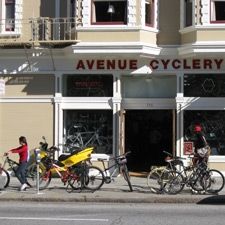Editor's note: The following article appears in the April 1 issue of Bicycle Retailer & Industry News
By Ray Keener
SAN FRANCISCO, CA—Stanyan Street in San Francisco, a three-block stretch of storefronts bordering the eastern edge of Golden Gate Park, once dominated bicycle retail in this cycling stronghold by the Bay.
For six decades, as many as eight stores along Stanyan offered every popular brand and price point, with many also renting bikes to Golden Gate visitors. Today, two retail operations remain. One thrives and one survives. What happened?
It’s a story of spiraling rents, shifting demographics, and cutthroat competition. And it revolves around American Cyclery, established by six-day racer Oscar Juner in 1941, and the oldest bicycle shop in San Francisco.
Today, American is the one thriving shop, at the southern end of Stanyan, with two locations across the street from each other. American serves everyone from commuters to roadies to fixie hipsters.
Bradley Woehl bought the store from Gene Maruszewski in 1996. Maruszewski had purchased the store from Juner five years earlier. Maruszewski was the first to see the chain-store future in the form of Start to Finish.
“I was a high-end mountain shop, and it went pretty well at first. I had great connections and a lot of groovy stuff,” Maruszewski recalled. “Gary Fisher was our main line, and then Start to Finish came in at the other end of the street and undercut us on price.”
Maruszewski was forced to sell to Woehl when he couldn’t handle the squeeze of debt service, low-price competition and an impatient landlord. Woehl was running Bicycle Trader, a newspaper at the time.
“Gene came to me and asked me to help liquidate his remaining inventory,“ said Woehl. “American was such an institution, I couldn’t let it go away, so I bought it rather than see it die.”
Today, Woehl is grossing $2.5 million out of the two locations, with sales springing back strongly after soft years in 2009 and 2010. Raleigh and Specialized are his two main bike lines, with bike sales accounting for more than 60 percent of gross sales.
And here’s the Stanyan story in a nutshell: “The big bike companies mostly moved their dealerships to warehouses south of Market Street where square footage is cheaper,” Woehl said.
“Mike’s Bikes [with nine stores and two more opening soon] carries the same lines we do, pays less rent, and has more purchasing power. It used to be Pacific Cycles undercutting us; now there are three Mike’s stores surrounding us.”
The rents on Stanyan Street were reasonable for decades, due to the Zeh family wanting to see bike stores remain there. Five of the Stanyan stores were owned by the Dutch family, and when they retired and sold out, rents reached their normal levels: too rich for bike-shop margins.
Avenue Cyclery is the other remaining shop on Stanyan. Owner Jason Mark has seen shifting product demand and declining sales. “We used to specialize in mountain bikes. Now we’re mostly a road and commuter shop,” Mark said.
Avenue sells Trek, Felt and Masi. “We were as high as $1.6 million in sales back in the ’90s; now we’re just under a million,” noted Mark. When corrected for inflation, Avenue is doing less than 40 percent of its heyday sales volume.
“We’re still here because our landlord loves bikes and we’re grandfathered into a decent rental rate,” said Mark.
While high rents and competition from Pacific Cycles, then Start to Finish and now Mike’s Bikes are key factors, the tiny storefronts and antiquated product presentation also hurt Stanyan.
Dave Guettler, co-founder of Pacific and now owner of River City Bicycles in Portland, Oregon, was blunt in his assessment: “They were crappy stores,” Guettler said. “Nothing distinguished them. There was a minimal amount of merchandising and marketing going on. Stanyan was so old-school, they lagged behind others by decades.”
As the surviving anchor of Stanyan Street, American’s Woehl is both optimistic and resigned. “I believe the allure of Stanyan Street as a center for bikes will continue to draw people,” he said. “It isn’t what it once was, and won’t ever be again.”




